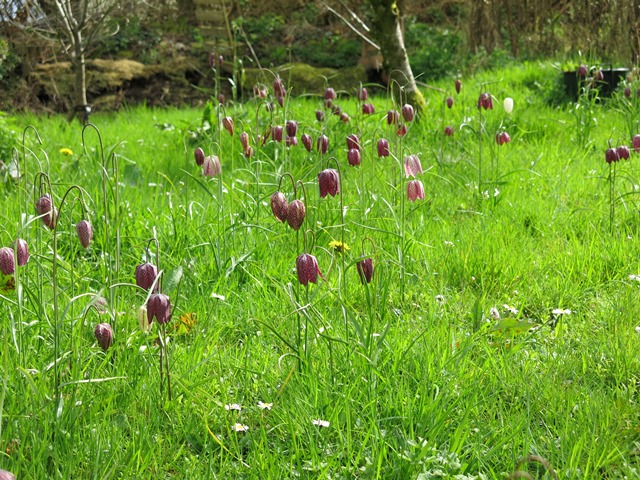Snake's Head Fritillary
As I walked in the meadow one lovely Spring day,
I watched all the dozens of wild grasses sway.
I looked at the wild flowers, examined each one.
I’d searched far and near (I never was done)
For the one special flower, like a sprite or a fairy,
‘Twas elusive and hidden, the wild Fritillary.
From “The Search for the Elusive Wild Fritillary” by Eleanor Vasak (1920-2015)
Overview
The snake’s head fritillary (Fritillaria meleagris) is a bulbous species of the lily-family. As you can guess from the excerpt from the poem by Eleanor Vasak, it is a species that can be quite elusive. The grass-like leaves help the species to blend in effectively in its natural habitat; meadows and other damp grasslands. However, all elusiveness disappears when the eye-catching bell-shaped flowers appear in spring. The purple, pink or sometimes white flowers with their characteristic chequered pattern, are highly visible poking out between the long grass.

In the early stages the young stem can display a peculiar creeping pattern: bending horizontal before growing upwards, and achieving a near vertical stature. That sounds snake-like to me. However, it was not the stem, but the flower, that has given it the name “snake’s head fritillary”. The name refers to the apparent similarity between the shape of the flower just before it opens, and a viper’s head.
When the snake’s head fritillary has found a good habitat, it will produce ample flowers, producing copious amounts of seed. Remarkably, seedlings in my garden are typically within a few feet from the mother plant, I’m not sure how dispersal is in the wild. Each peduncle (flowering stem) can carry one, two or rarely three flowers. However, this is where the snake’s head fritillary displays a remarkable sense of “undecidedness”. To branch or not to branch, to produce one flower, two flowers (or is one big flower a better option)?
Branching
Most common in my garden are plants with a single unbranched peduncle, carrying one flower.;

However, many plants display division of the peduncle into two branches (dichotomous branching), with each branch carrying its own flower. Typically, peduncles branch some 6-7 cm below the flower head. However, some plants leave the branching till late, with just 1-2 cm between branching and flower heads, resulting in closely packed flowers.

Other (procrastination in the plant kingdom?) fritillaries delay peduncle branching so long that the two distinct flowers seem positioned on the same single, unbranched peduncle.

Leaving peduncle branching aside, some fritillaries even seem to be in doubt whether or not to have two flowers in the first place. This can be seen as double flowers. They carry a double sets of stamen and of 3-cleft styles within a single very large flower made up of a double set of sepals and petals.




So it seems the snake’s head fritillary isn’t able to make up its mind about whether to produce 1, 2 or 3 flowers on one stem. However, I surmise that this story is likely to be more complex than it appears. In many bulbous species flower formation is initiated in the previous summer and autumn. Thus, last year’s weather may have played a key role in determining this year’s variety in flower numbers. But what about the branching of the peduncle? Peduncle growth is mostly controlled by the current weather. So, there you have it, past and present weather conditions together control floral structure of snake’s head fritillary.
